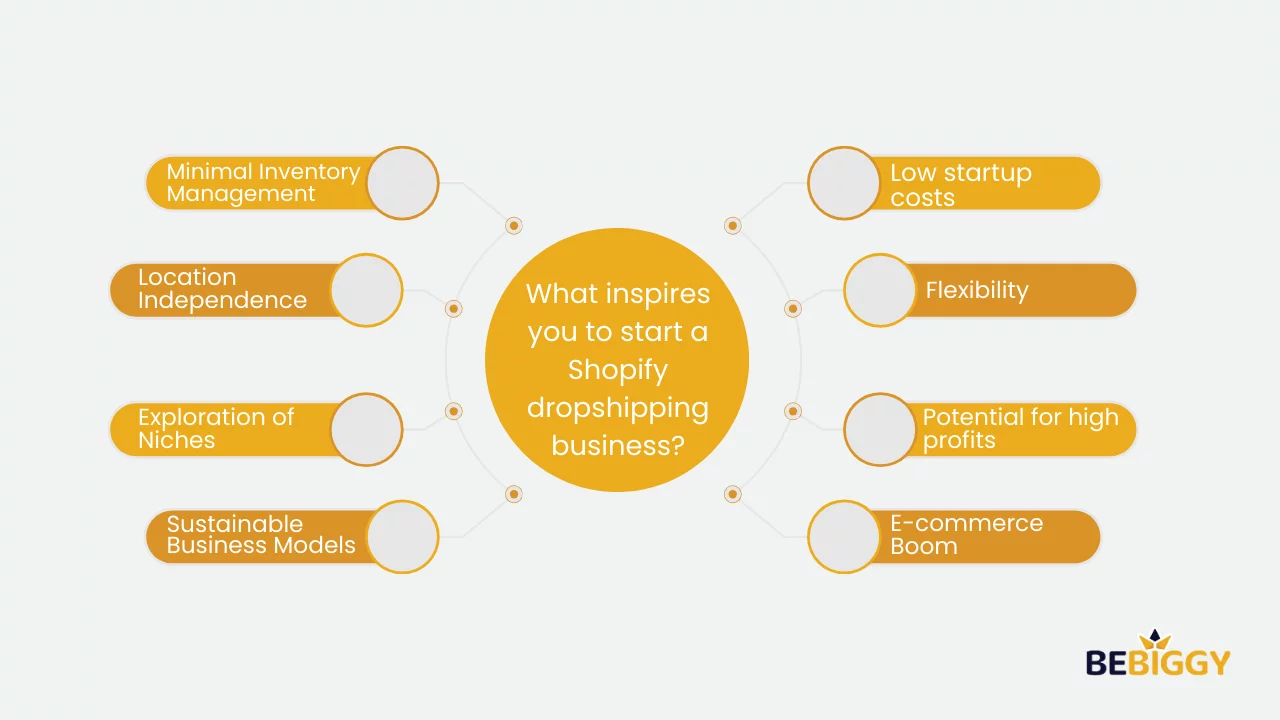Today, we’ll explore some successful Shopify Dropshipping Examples!
The world of e-commerce has witnessed a phenomenal transformation in recent years, and the rise of Shopify dropshipping has been nothing short of revolutionary. This innovative business model has empowered countless entrepreneurs to build successful online ventures without the traditional challenges of inventory management and upfront investments.
Whether you’re a newcomer to e-commerce or an experienced merchant seeking fresh insights, these examples will shed light on the secrets to prosperity in Shopify dropshipping.
So, let’s dive into the tales of triumph and the strategies behind them, inspiring you to embark on your journey to e-commerce success.
Here are some other interesting dropshipping stats:
According to a recent study by Oberlo, the global dropshipping market is expected to reach $565.47 billion by 2027. This implies a 23.4% compound annual growth rate.
- Dropshipping accounts for approximately 34% of all Amazon sales.
- The average Amazon dropshipper makes between $1,000 and $50,000 per month.
- The top 10% of Amazon dropshippers make over $100,000 per month.
- Shopify is the leading e-commerce platform for dropshipping, with over 1 million
- The average dropshipper makes between $1,000 and $5,000 per month.
Understanding Dropshipping and the Significance of Building a Shopify Dropshipping Store
Dropshipping is a retail fulfillment technique that does away with the requirement for a retailer to maintain inventory. In contrast, a shop using a dropshipping model buys a product from a third-party supplier and ships it straight to the buyer.
The significance of building a Shopify dropshipping store lies in the low barriers to entry, minimal upfront investment, and the opportunity to explore the booming e-commerce market without the complexities of traditional retail.
This approach simplifies your journey, reduces financial risk, and creates a path for entrepreneurs to embark on their online business adventure. Shopify, a leading e-commerce platform, provides the tools and support needed to facilitate this venture effectively, opening doors to success.
Shopify Dropshipping Examples: Success Stories

1. HYGO
HYGO is a Shopify dropshipping store that sells various products, including gadgets, home goods, and clothing. HYGO was founded in 2017 and has since become one of the largest Shopify dropshipping stores in the world. The secret to HYGO’s success is its commitment to providing a large assortment of premium goods at affordable costs.
The following are some stats related to HYGO:
- The company has a team of 11 to 50 employees.
- Their yearly revenue falls from $1 million to $2 million.
- Their global rank is approximately 4,307,060.
2. Allbirds
Allbirds, a thriving store on the Shopify platform, has garnered remarkable success through its commitment to sustainability, innovative use of eco-friendly materials, and a focus on comfortable, stylish footwear.
With a wide range of products, including their signature “Tree” and “Wool” collections, Allbirds has captured the attention of environmentally conscious consumers. Their dedication to minimizing their carbon footprint, both in their materials and retail practices, has contributed to their success and recognition as a leader in sustainable fashion.
The following are some stats related to Allbirds:
- Net revenue experienced a 4% decrease, totaling $54.4 million compared to the previous year while showing a 9.5% increase compared to 2021.
- Allbirds reported a net loss of $35.2 million, equivalent to $0.23 per basic and diluted share.
- Adjusted EBITDA1 resulted in a loss of $21.7 million.
- Allbirds unveiled “M0.0NSHOT,” an ambitious project to create the world’s first net-zero carbon shoe, highlighting their commitment to sustainability.
- The first quarter of the year saw a notable 6% reduction in cash usage compared to the same period in 2022.
In April 2023, the company extended and upsized an undrawn revolver in partnership with JP Morgan.
3. Stitch Fix
Stitch Fix is a popular online personal styling service that connects customers with expert stylists to curate personalized clothing selections. Customers provide their style preferences, and Stitch Fix’s algorithms and professional stylists collaborate to send them a tailored “Fix” of clothing and accessories.
This innovative approach to fashion retail has gained a strong following among those seeking convenience and curated style recommendations.
The following are some stats related to Stitch Fix:
- In the full year of fiscal 2023, the company reported a net revenue of $1.6 billion, reflecting a 21% decrease compared to the previous year.
- The number of active clients also declined, with 3,297,000 active clients in the fiscal year, which decreased by 498,000 or 13% year-over-year.
- The net revenue per active client (RPAC) stood at $497, showing a 9% decrease from the previous year.
- The company reported a net loss of $172.0 million and a diluted loss per share of $1.50.
- Adjusted EBITDA measures earnings before interest, taxes, depreciation, and amortization. It was reported at $16.8 million.
4. Dixxon Flannel
Dixxon Flannel is a clothing company that specializes in high-quality flannel shirts. Founded in 2012, Dixxon is known for its classic style, commitment to sustainability, and loyal customer base.
Dixxon Flannel shirts are made with the finest materials and craftsmanship. The company uses organic cotton and recycled materials in its products and offsets its carbon emissions.
The following are some stats related to Dixxon Flannel:
- Founded in 2012, Dixxon Flannel has rapidly grown to generate over $20 million in revenue annually.
- They regularly experience high demand for their products, with individual colorways often selling out within minutes to 30 minutes of release.
- Dixxon Flannel boasts a workforce of over 100 employees.
- They’ve successfully sold more than 1 million flannel shirts to date.
- Their products are distributed through a network of over 1,000 retailers
5. Taylor Stitch
Taylor Stitch is a well-known apparel brand known for its commitment to sustainable fashion. Founded in 2008, they have established themselves as a leader in the industry, focusing on crafting timeless, durable clothing. Their dedication to responsible manufacturing and use of eco-friendly materials has garnered them a strong and loyal customer base.
The following are some stats related to Taylor Stitch:
- The company employs a team ranging from 11 to 50 individuals.
- Taylor Stitch boasts an impressive annual revenue within the $5 to $7 million
- Customers can start shopping for their products with prices as low as $26.
6. Wanderlust
Wanderlust is a Shopify dropshipping store that sells travel gear and accessories. Wanderlust was founded in 1993 and has become a popular store among travelers and outdoor enthusiasts. Wanderlust’s success is due to its focus on selling high-quality products that are both functional and stylish.
The following are some stats related to Wanderlust:
- Wanderlust was established in
- The company has between 11 and 50 employees.
- Wanderlust’s yearly revenue amounts to $1.6 million.
7. Minimalist
Minimalist is a Shopify dropshipping store that sells minimalist home decor and accessories. Minimalist has become popular for its well-curated selection of products and its commitment to sustainability.
With a dedicated team, Minimalist ensures swift responses to customer inquiries and swift order fulfillment, consistently earning high praise for its reliable service.
The following are some stats related to Minimalist:
- It achieved over $1 million in sales in
- It maintains a customer base of over 50,000 people.
- It ships products to more than 50 countries worldwide.
8. Bella Canvas
Bella Canvas is a Shopify dropshipping store that sells high-quality blank apparel. Bella Canvas is known for its sustainable manufacturing practices and its wide range of products.
Its extensive product range covers a wide spectrum of styles, sizes, and colors, making it a top choice for those in the fashion and customization industry. Bella Canvas continually updates its collections to stay in line with fashion trends and customer demands.
The following are some stats related to Bella Canvas:
- It generates over $100 million in annual revenue.
- It employs a workforce of over 1,000 employees.
- It ships its products to over 200 countries around the globe.
9. Redbubble
Redbubble is a Shopify dropshipping platform that lets people sell their designs on a variety of products, for instance, t-shirts, mugs, and phone cases. Redbubble is popular for its wide range of designs and its commitment to helping artists make money from their work.
Redbubble’s commitment to artistic expression is further amplified through its dedication to fair compensation for creators.
The following are some stats related to Redbubble:
- Achieves annual revenue exceeding $500 million.
- It Boasts a vast community of over 2 million artists selling their creations on the platform.
- Attracts over 50 million unique visitors each month to explore and purchase artistic designs.
10. Society6
Society6 is another Shopify dropshipping platform that allows users to sell their designs on various products. Society6 is similar to Redbubble but has a more focused selection of designs and products.
Society6 fosters a sense of community among its creators, allowing artists to connect and gain recognition for their work. Its commitment to showcasing exceptional art in everyday products adds an extra layer of character and originality to the world of e-commerce.
The following are some stats related to Society6:
- Garners an annual revenue of over $100 million.
- Provides a platform for more than 500,000 artists to showcase and sell their artwork.
- Draws in over 20 million unique visitors monthly, exploring the world of creative designs and artistry.
Key Strategies for Shopify Dropshipping Success

1. Niche Selection
Selecting the Right Niche: The first step is to choose a niche when starting a Shopify dropshipping venture. A niche is a specific market segment; your choice should be based on thorough research. Assess market trends to identify niches with growing demand.
Understanding Competition: Study your potential competitors within the chosen niche. Recognize their strengths and weaknesses, and look for opportunities to differentiate your store.
Passion and Expertise: Consider your personal interests and expertise. Working in a niche that aligns with your passion can make your dropshipping journey more enjoyable and sustainable.
Important stats to know:
- Research shows that businesses that target a specific niche are 24% more likely to be profitable within the first year.
- Approximately 75% of consumers consider a brand’s competition when purchasing.
- Entrepreneurs passionate about their niche are three times more likely to succeed.
2. Reliable Suppliers
Supplier Due Diligence: Finding trustworthy suppliers is vital for successful dropshipping. Research potential suppliers meticulously to ensure they offer quality products and dependable shipping services.
Open Communication: Establish strong communication channels with your suppliers. Good communication helps you address issues quickly and maintain a reliable working relationship.
Important stats to know:
- 84% of consumers would stop buying from a brand if they received one poor-quality product.
- 95% of consumers claim that quality shipping and handling influences brand loyalty.
- Effective communication reduces the risk of 60% of order errors
3. Effective Marketing
Robust Marketing Strategy: Crafting a comprehensive marketing strategy is crucial. Use digital marketing techniques, for instance, Social Media Marketing, SEO, and Email Marketing, to increase your store’s visibility.
Engaging Content: Create engaging and relevant content to attract and retain your target audience. Develop compelling product descriptions, blog posts, and social media content to connect with potential customers.
Paid Advertising: Use paid advertising through platforms like Google Ads and Facebook Ads to effectively reach your target market. Invest in advertising wisely to maximize your ROI.
Important stats to know:
- 92% of marketers stated that their social media efforts increased their exposure.
- Compared to traditional marketing, content marketing produces three times as many leads.
- Companies with blogs get 97% more links pointing to their website.
- The average expenditure for Google Ads campaigns typically falls between $9,000 and $10,000, with an estimated cost per click (CPC) between $2 and $5.
4. Customer Service
Quick Responses: Providing excellent customer service is key. Respond promptly to customer inquiries, addressing their questions or concerns.
Hassle-free Returns: Offer hassle-free return and refund policies. A customer-friendly return process can significantly enhance your store’s reputation and encourage repeat business.
Important stats to know:
- 5% of customers say they’re more likely to purchase if their questions are answered promptly.
- 67% of consumers check the return policy before buying a product.
5. Competitive Pricing
Monitoring Market Prices: Keep an eye on product pricing in your niche. Stay competitive by adjusting your prices or offering discounts, bundle deals, or promotions when feasible.
Pricing Intelligence Tools: Use pricing intelligence tools to ensure your pricing aligns with the market. This results in helping you maintain a competitive edge and adapt to market changes.
Important stats to know:
- 68% of consumers compare prices before making a purchase.
- Retailers who use pricing intelligence tools see an average profit increase of 10-25%.
6. Inventory Management
Preventing Stockouts: Efficient inventory management is crucial to prevent stockouts. Implement inventory tracking and forecasting tools to keep products in stock when needed.
Sales Trend Analysis: Regularly analyze sales trends to make informed decisions about restocking. Understanding which products are popular at different times can prevent overstocking and understocking.
Important stats to know:
- If you’re out of stock, 57% of consumers will leave your site and go to a competitor’s site.
- Accurate sales trend analysis can reduce excess inventory by 20% and increase sales
by 10-15%.
7. Customer Feedback and Adaptation
Continuous Feedback: Get input from customers regularly. Invite clients to provide their thoughts, recommendations, and evaluations.
Adaptive Approach: Make changes to your store and services based on customer input. Make adjustments following consumer preferences to improve the general shopping experience and foster brand loyalty.
Important stats to know:
- 77% of customers view brands more favorably if they seek their feedback.
- Businesses that adapt based on customer feedback experience an average revenue increase of 18%.
Leveraging Dropshipping Automation Tools

In the world of dropshipping, efficiency is key. To succeed, you need to harness the power of dropshipping automation tools that can significantly streamline your operations. With these solutions, you may automate several business processes, such as inventory control and order processing, freeing up time for expansion and client delight.
Some popular automation tools for dropshipping are mentioned below:
Oberlo
- Oberlo is a user-friendly Shopify app that simplifies product import and order fulfillment for your dropshipping store.
- It allows you to effortlessly add products to your shop and automate order processing by connecting you with several vendors.
- Features include automatic price and inventory updates, real-time shipment tracking, and customizable product listings.
Inventory Source
- Inventory Source is an automation platform that seamlessly integrates with popular e-commerce platforms.
- It provides real-time product data synchronization, order routing, and a vast directory of trusted suppliers.
- This tool helps reduce manual data entry and enhances inventory management efficiency.
eComDash
- eComDash is a multi-channel inventory and order management software designed to automate various aspects of your e-commerce business.
- It synchronizes inventory across different sales channels, centralized order processing, and automated shipping and tracking.
- eComDash allows you to streamline your operations, saving time and reducing errors.
The Role of Social Media in Dropshipping Success

Social media plays an important role in the success of Shopify dropshipping ventures, offering a dynamic platform for marketing, customer engagement, and community building.
Social Media Marketing: Shopify dropshipping stores utilize platforms like Instagram and Facebook for effective product marketing through posts, stories, and ads.
Influencer Collaborations: Dropshippers often partner with influencers to promote products to their followers, expanding brand reach and credibility.
Paid Advertising: Paid advertising on social media enables targeted marketing, reaching potential customers efficiently and cost-effectively.
Building Niche Communities: Online communities centered around specific products or niches foster brand loyalty and engage potential customers.
Direct Engagement: Social media platforms enable direct customer interaction, facilitating feedback and enhancing customer service.
Examples:
- A Shopify store that sells eco-friendly products collaborates with eco-conscious influencers on Instagram, increasing sales.
- Paid Facebook ads targeting fitness enthusiasts drive traffic to a dropshipping store offering workout equipment.
- A Shopify dropshipping store focusing on pet products builds a thriving online community around pet lovers, encouraging discussions and product recommendations.
- Customer feedback on social media prompts a dropshipper to introduce a new line of products based on user preferences.
Here are some stats related to the role of social media in dro
- 86% of Shopify dropshipping stores use social media to promote their products.
- Shopify dropshipping stores that use social media marketing see a 17% increase in sales.
- Facebook is the most well-known social networking platform for Shopify dropshipping stores, followed by Instagram and TikTok.
- The average Shopify dropshipping store spends 10% of its marketing budget on social media.
- Shopify dropshipping stores that use social media to engage with customers have a higher customer satisfaction rate.
Case Study: Scaling a Dropshipping Business
- Company: HYGO
- Industry: Dropshipping
- Products: Gadgets, home goods, clothing
- Revenue: Over $10 million in 2022
- Customer base: Over 500,000 people
- Ships to: Over 100 countries
How They Scaled:
Focused on building a strong brand: HYGO invested heavily in building a strong brand identity and reputation. This includes creating a distinctive value proposition, designing an eye-catching website, and establishing a powerful social media presence.
Expanded their product selection: HYGO started by selling a small selection of products. However, as they grew, they expanded their product selection to include a wider range of items. This helped them to attract more customers and increase their sales.
Optimized their marketing campaigns: HYGO experimented with different marketing channels and strategies to find what worked best for their business. They also invested in paid advertising to reach a wider audience.
Improved their customer service: HYGO made customer service a top priority. They responded to customer inquiries promptly and resolved issues quickly and efficiently. This helped them to build customer loyalty and repeat business.
Statistical Data:
- HYGO’s revenue grew by over 200% in 2022.
- HYGO’s customer base grew by over 100% in 2022.
- HYGO’s average order value is over $100.
- HYGO’s conversion rate is over 2%.
- HYGO’s customer satisfaction rate is over 90%.
HYGO’s success story shows that it can scale a dropshipping business to great heights. However, it is important to note that dropshipping is not a get-rich-quick scheme. It requires hard work, dedication, and a willingness to learn.
Building a Strong Online Presence with BeBiggy
In the world of dropshipping, building a strong online presence is paramount, and one effective way to achieve this is through pre-built online stores offered by platforms like BeBiggy.
BeBiggy provides entrepreneurs a diverse range of fully optimized e-commerce stores, making it a convenient option for those seeking established online businesses.
By leveraging the expertise and resources of platforms like BeBiggy, aspiring dropshippers can access a selection of ready-to-go e-commerce stores, complete with product listings and essential features. These pre-built stores save time and allow entrepreneurs to focus on strategies, marketing, and customer engagement.
Whether you are looking for a turnkey solution to kickstart your dropshipping journey or seeking additional revenue streams, platforms like BeBiggy offer valuable opportunities in the dynamic world of e-commerce.
Shopify Dropshipping vs. Traditional Retail
- Low Initial Cost: Shopify dropshipping requires minimal upfront investment, while traditional retail demands substantial capital for inventory, space, and staffing.
- Ease of Entry: Shopify offers a user-friendly platform, making it accessible to newcomers, whereas traditional retail involves complex logistics and challenges for beginners.
- Lower Overhead: Shopify dropshipping operates online, reducing overhead costs such as rent, utilities, and employee wages, in contrast to traditional retail with its substantial operational expenses.
- Market Reach: Shopify enables global reach, allowing you to tap into a vast online market, while traditional retail largely depends on local or regional customer bases.
- Inventory Management: Shopify dropshipping eliminates the need for warehousing and inventory management, simplifying operations, while traditional retail requires inventory maintenance and storage.
- Flexibility: Shopify offers flexibility in managing your business from anywhere, providing a digital advantage, while traditional retail often ties you to a physical location.
- Competition: Shopify’s online landscape comes with competition, but it’s less saturated than traditional retail markets, which often have many established competitors.
Pros and Cons of Shopify Dropshipping

Pros
- Low Initial Investment: You can start a dropshipping business with minimal capital, as purchasing and storing inventory is unnecessary.
- Easy Setup: Shopify provides an intuitive platform. It makes it simple for beginners to create and manage an online store.
- Wide Product Range: With dropshipping, you can offer a broad range of products without the hassle of stocking them.
- Location Independence: With an internet connection, you can operate your Shopify dropshipping business from anywhere.
- Scalability: As your business grows, it’s easy to scale up and add more products or expand into different niches.
- Reduced Risk: Since you don’t pre-purchase inventory, you’re not stuck with unsold products.
- Diverse Suppliers: Shopify offers access to various suppliers and products, increasing flexibility.
- Marketing Options: The platform offers numerous marketing tools and integrations to help promote your store.
- Abundant Resources: Shopify offers many resources, including guides, webinars, and a supportive community. This makes it easier for newcomers to learn the ropes.
- App Ecosystem: You can enhance your store’s functionality with a wide range of Shopify apps, from SEO optimization to inventory management, helping you tailor your business to your needs.
Cons
- Competition: The dropshipping market can be competitive, requiring effective marketing strategies to stand out.
- Thin Profit Margins: With various costs, profit margins can be narrow, especially for low-priced items.
- Dependence on Suppliers: The reliability and quality of your suppliers can affect your business’s reputation.
- Shipping Times: Some suppliers may have longer shipping times, which can lead to customer dissatisfaction.
How To Make $50,000 From Real Dropshippers

Creating a substantial income from dropshipping is achievable with the right strategies. To make $50,000 from real dropshippers, consider the following key steps:
- Research and Select Your Niche Wisely: Analyze market trends and competition to choose a profitable niche that aligns with your interests.
- Focus on SEO: Implement strong SEO practices to improve your store’s visibility and drive organic traffic.
- Strategic Pricing: Set competitive yet profitable prices and consider factors like shipping and supplier costs.
- Customer Service: Prioritize excellent customer service to build trust and maintain a positive reputation.
- Testing and Optimization: Continuously test various strategies, products, and ad campaigns to optimize your business for success.
- Stay Informed: Keep up with industry news and changes in e-commerce trends to adapt your strategies accordingly.
- Networking: Join e-commerce communities and forums to learn from experienced dropshippers and seek advice when needed.
- Customer Retention: Develop retention strategies, such as loyalty programs, email marketing, and personalized offers.
- Legal Compliance: Understand the legal aspects of e-commerce, including taxes, data protection, and product regulations.
- Persistence: Be prepared for challenges and setbacks; persistence and adaptability are key to long-term success.
What inspires you to start a Shopify dropshipping business?

Here are some of the reasons why people are inspired to start a Shopify dropshipping business:
- Low startup costs: Shopify dropshipping businesses require very little upfront investment. This makes it a good option for people new to entrepreneurship or with limited financial resources.
- Flexibility: Dropshipping businesses can be run from anywhere in the world, and they don’t require any inventory to be held. This makes them a good option for people who want to be their boss or who want to travel while they work.
- Potential for high profits: Dropshipping businesses can be very profitable, especially if they are run well. However, it is important to note that there is no guarantee of success, and it takes hard work and dedication to build a successful dropshipping business.
- E-commerce Boom: The instant growth of the e-commerce industry and the increasing preference of consumers for online shopping inspire entrepreneurs to tap into this burgeoning market.
- Minimal Inventory Management: Dropshipping eliminates the need to buy, store, and manage products, reducing operational hassles.
- Location Independence: The flexibility of running a dropshipping business from anywhere with an internet connection is a significant inspiration.
- Exploration of Niches: Dropshippers can test multiple niches and product categories to find the best.
- Sustainable Business Models: The concept of building a sustainable and eco-friendly business inspires those who are committed to reducing their carbon footprint.
FAQs Related to Shopify Dropshipping

What are the best examples of Shopify dropshipping stores?
Some of the best examples of Shopify dropshipping stores include Allbirds, Dixxon Flannel, and Wanderlust.
Which products have been the most successful for dropshipping on Shopify?
Shopify’s most successful dropshipping products vary but often include unique and niche items, like sustainable footwear and high-quality flannel shirts.
How can I find Shopify dropshipping stores for inspiration?
Numerous apps in the Shopify App Store are designed for dropshipping businesses. You can browse these apps to find examples of successful Shopify dropshipping stores.
Who are the best suppliers for Shopify dropshipping?
The best suppliers for Shopify dropshipping vary depending on the niche and products you sell. However, some popular suppliers include AliExpress, Spocket, and Oberlo.
Where is the best place to purchase pre-built online stores?
If you’re searching for pre-built Shopify stores, BeBiggy offers a diverse range of fully optimized eCommerce businesses, making it a convenient one-stop destination.
Why is dropshipping a popular choice for aspiring e-commerce entrepreneurs?
Dropshipping is popular for aspiring e-commerce entrepreneurs due to its low entry barriers and minimized financial risk.
What are the benefits of building a Shopify dropshipping store for newcomers to the e-commerce world?
Building a Shopify dropshipping store offers newcomers to the e-commerce world the benefits of minimal upfront investment, simplified inventory management, and the opportunity to explore the online market without the complexities of traditional retail.
How have these Shopify dropshipping success stories adapted to market trends and customer preferences?
These success stories have thrived by consistently adapting to market trends and attentively listening to their customers.
What role does effective marketing play in the triumph of Shopify dropshipping businesses?
Effective marketing drives traffic, engages customers, and increases a store’s visibility in the highly competitive Shopify dropshipping landscape.
Why is customer service considered a cornerstone of success in the dropshipping model?
Customer service is vital to Shopify’s dropshipping success, ensuring customer satisfaction, trust, and repeat business.
Conclusion
In the dynamic world of e-commerce, Shopify dropshipping stands as a beacon of opportunity for entrepreneurs. You’ve unlocked valuable insights into this revolutionary business model by exploring the inspiring success stories and essential strategies shared in this guide.
The significance of building a Shopify dropshipping store lies in its low barriers to entry, cost-effectiveness, and vast market reach. Niche selection, reliable suppliers, effective marketing, customer service, competitive pricing, and adaptive inventory management are the pillars of success.
As you embark on your dropshipping journey, remember that perseverance and constant adaptation are the keys to unlocking the limitless potential of Shopify dropshipping.












 What Is Shopify Dropshipping and How Does It Work?
What Is Shopify Dropshipping and How Does It Work?  Shopify Dropshipping: What You Need to Know Before Buying a Business?
Shopify Dropshipping: What You Need to Know Before Buying a Business?  How to Dropship on Shopify: Step-by-Step Guide
How to Dropship on Shopify: Step-by-Step Guide  Payment Gateways for Shopify: Secure Transactions
Payment Gateways for Shopify: Secure Transactions